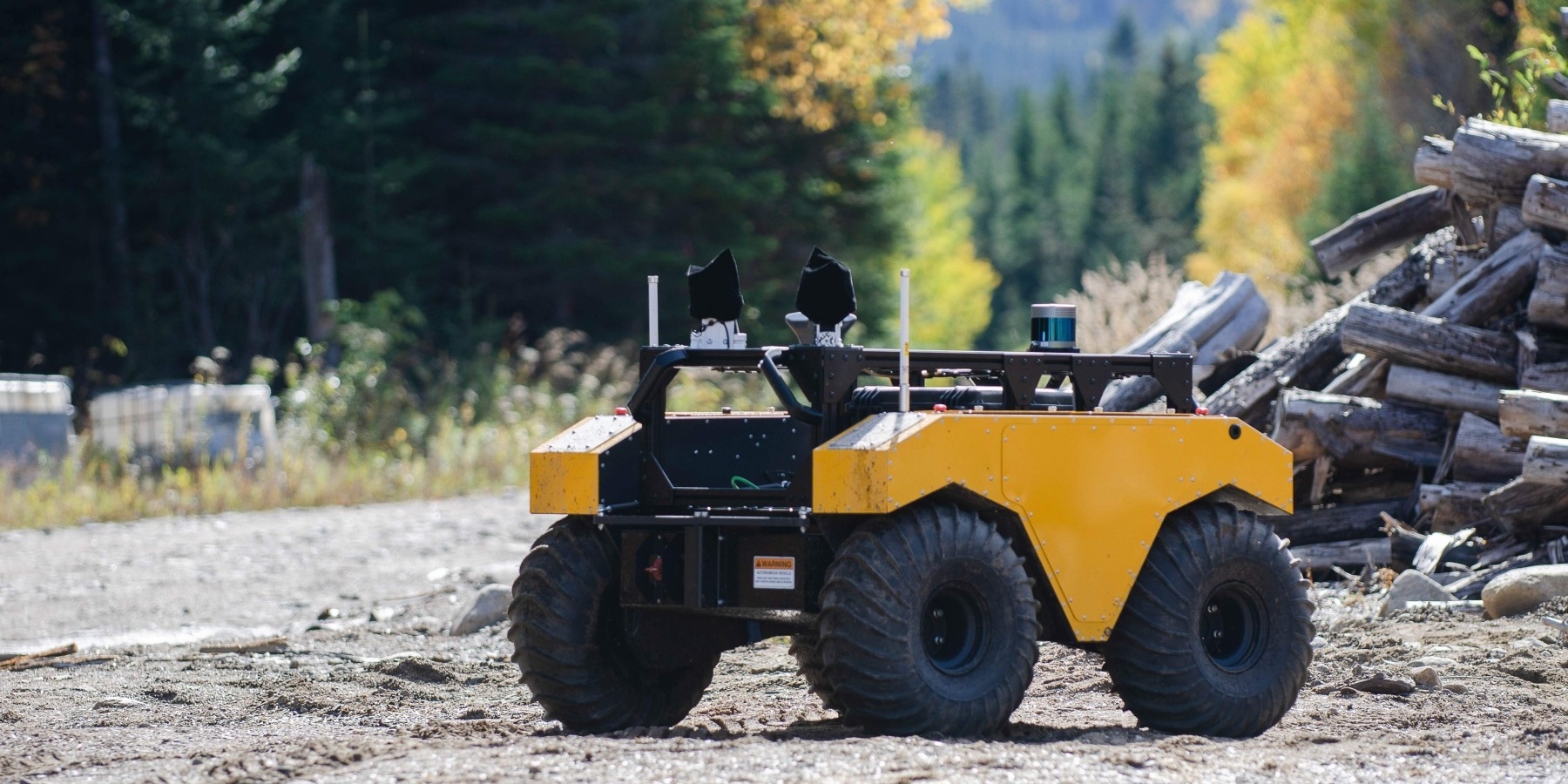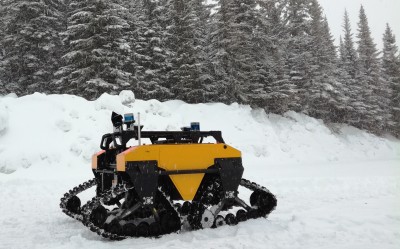The Self-driving Navigation Optimized for Winter (SNOW) project allowed a robotic team from Université Laval to provide a better navigation solution for Unmanned Ground Vehicle (UGV) in unstructured and dynamic environments generated by winter conditions. The multiple kinds of precipitation in winter disrupt autonomous driving algorithms and will augment the risk of deploying such technology on Canadian roads. This project addressed the lack of knowledge around the interaction of winter conditions and autonomous vehicles, in addition to a small amount of expertise available to support policymakers.
Quick jump to:
Objectives
- Mapping and Localization: to develop algorithms to allow the UGV to localize and map its environment in winter conditions.
- Path Planning and Control: to develop algorithms for planning paths and adapt the behaviour of the UGV according to weather conditions along with the reality of the ground and obstacles rigidity.
- Field Testing and Integration: to carry out an extensive series of experiments using the UGV in a snow-covered forest. These experiment campaigns will serve as motivation to integrate modules to enhance the autonomy of a UGV.
Reports
Media
People
Publications
Journal Articles
- Baril, D., Deschênes, S.-P., Gamache, O., Vaidis, M., LaRocque, D., Laconte, J., Kubelka, V., Giguère, P., & Pomerleau, F. (2022). Kilometer-scale autonomous navigation in subarctic forests: challenges and lessons learned. Field Robotics, 2(1), 1628–1660. https://doi.org/10.55417/fr.2022050
PDF Publisher Bibtex source - Chahine, G., Vaidis, M., Pomerleau, F., & Pradalier, C. (2021). Mapping in unstructured natural environment: A sensor fusion framework for wearable sensor suites. SN Applied Sciences, 3(5).
Bibtex source - Kasmi, A., Laconte, J., Aufrère, R., Denis, D., & Chapuis, R. (2020). End-to-end probabilistic ego-vehicle localization framework. IEEE Transactions on Intelligent Vehicles.
Bibtex source - Kubelka, V., Dandurand, P., Babin, P., Giguère, P., & Pomerleau, F. (2020). Radio propagation models for differential GNSS based on dense point clouds. Journal of Field Robotics. https://doi.org/10.1002/rob.21988
Publisher Bibtex source - Labussière, M., Laconte, J., & Pomerleau, F. (2020). Geometry Preserving Sampling Method based on Spectral Decomposition for Large-scale Environments. Frontiers in Robotics and AI – Multi-Robot Systems, 7, 134. https://doi.org/10.3389/frobt.2020.572054
Publisher Bibtex source
Conference Articles
- LaRocque, D., Guimont-Martin, W., Duclos, D.-A., Giguère, P., & Pomerleau, F. (2024). Proprioception Is All You Need: Terrain Classification for Boreal Forests. 2024 IEEE/RSJ International Conference on Intelligent Robots and Systems (IROS), 11686–11693. https://doi.org/10.1109/iros58592.2024.10801407
PDF Slides Publisher Bibtex source - Gamache, O., Fortin, J.-M., Boxan, M., Vaidis, M., Pomerleau, F., & Giguère, P. (2024). Exposing the Unseen: Exposure Time Emulation for Offline Benchmarking of Vision Algorithms. IEEE/RSJ International Conference on Intelligent Robots and Systems (IROS), 11110–11117. https://doi.org/10.1109/IROS58592.2024.10803057
Publisher Bibtex source - Deschênes, S.-P., Baril, D., Boxan, M., Laconte, J., Giguère, P., & Pomerleau, F. (2024). Saturation-Aware Angular Velocity Estimation: Extending the Robustness of SLAM to Aggressive Motions. Proceedings of the IEEE International Conference on Robotics and Automation (ICRA). https://doi.org/https://doi.org/10.48550/arXiv.2310.07844
PDF Publisher Bibtex source - Baril, D., Deschênes, S.-P., Coupal, L., Goffin, C., Lépine, J., Giguère, P., & Pomerleau, F. (2024). DRIVE: Data-driven Robot Input Vector Exploration. Proceedings of the IEEE International Conference on Robotics and Automation (ICRA). https://doi.org/10.1109/ICRA57147.2024.10611172
Publisher Bibtex source - Kubelka, V., Vaidis, M., & Pomerleau, F. (2022). Gravity-constrained point cloud registration. Proceedings of the IEEE International Conference on Intelligent Robots and Systems (IROS), 4873–4879. https://doi.org/10.1109/IROS47612.2022.9981916
Publisher Bibtex source - Laconte, J., Randriamiarintsoa, E., Kasmi, A., Pomerleau, F., Chapuis, R., Debain, C., & Aufrère, R. (2021). Dynamic Lambda-Field: A Counterpart of the Bayesian Occupancy Grid for Risk Assessment in Dynamic Environments. Proceedings of the IEEE International Conference on Intelligent Robots and Systems (IROS).
Bibtex source - Deschênes, S.-P., Baril, D., Kubelka, V., Giguère, P., & Pomerleau, F. (2021). Lidar Scan Registration Robust to Extreme Motions. 2021 18th Conference on Robots and Vision (CRV). https://doi.org/10.1109/CRV52889.2021.00014
PDF Publisher Bibtex source - Kasmi, A., Laconte, J., Aufrère, R., Theodose, R., Denis, D., & Chapuis, R. (2020). An Information Driven Approach For Ego-Lane Detection Using Lidar And OpenStreetMap. 2020 16th International Conference on Control, Automation, Robotics and Vision (ICARCV), 522–528.
Bibtex source - Baril, D., Grondin, V., Deschenes, S., Laconte, J., Vaidis, M., Kubelka, V., Gallant, A., Giguere, P., & Pomerleau, F. (2020). Evaluation of Skid-Steering Kinematic Models for Subarctic Environments. 2020 17th Conference on Computer and Robot Vision (CRV), 198–205. https://doi.org/10.1109/CRV50864.2020.00034 Best Robotic Vision Paper Award!
PDF Publisher Bibtex source - Dandurand, P., Babin, P., Kubelka, V., Giguère, P., & Pomerleau, F. (2019). Predicting GNSS satellite visibility from dense point clouds. Proceedings of the Conference on Field and Service Robotics (FSR). Springer Tracts in Advanced Robotics.
PDF Bibtex source - Pradalier, C., Aravecchia, S., & Pomerleau, F. (2019). Multi-session lake-shore monitoring in visually challenging conditions. Proceedings of the Conference on Field and Service Robotics (FSR). Springer Tracts in Advanced Robotics.
Bibtex source - Landry, D., Pomerleau, F., & Giguère, P. (2019). CELLO-3D: Estimating the Covariance of ICP in the Real World. Proceedings of the IEEE International Conference on Robotics and Automation (ICRA).
PDF Bibtex source - Babin, P., Giguère, P., & Pomerleau, F. (2019). Analysis of Robust Functions for Registration Algorithms. Proceedings of the IEEE International Conference on Robotics and Automation (ICRA). https://doi.org/10.1109/ICRA.2019.8793791
PDF Publisher Bibtex source - Babin, P., Dandurand, P., Kubelka, V., Giguère, P., & Pomerleau, F. (2019). Large-scale 3D Mapping of Subarctic Forests. Proceedings of the Conference on Field and Service Robotics (FSR). Springer Tracts in Advanced Robotics.
PDF Slides Bibtex source - Laconte, J., Debain, C., Chapuis, R., Pomerleau, F., & Aufrere, R. (2019). Lambda-Field: A Continuous Counterpart of the Bayesian Occupancy Grid for Risk Assessment. Proceedings of the IEEE International Conference on Intelligent Robots and Systems (IROS).
Bibtex source
Miscellaneous
- Dubois, W., Boxan, M., Laconte, J., & Pomerleau, F. (2024). 3D Mapping of Glacier Moulins: Challenges and lessons learned. presented to the 2024 Workshop on Field Robotics from IEEE International Conference on Robotics and Automation (ICRA). https://arxiv.org/abs/2404.18790
Publisher Bibtex source - Gamache, O., Fortin, J.-M., Boxan, M., Pomerleau, F., & Giguère, P. (2024). Field Report on a Wearable and Versatile Solution for Field Acquisition and Exploration. presented to the 2024 Workshop on Field Robotics from IEEE International Conference on Robotics and Automation (ICRA). https://doi.org/10.48550/arXiv.2405.00199
Publisher Bibtex source - Daum, E., Vaidis, M., & Pomerleau, F. (2023). Benchmarking ground truth trajectories with robotic total stations. presented at IROS23, Workshop on Methods for Objective Comparison of Results in Intelligent Robotics Research. https://arxiv.org/abs/2309.05134 Best paper award!
Publisher Bibtex source - Deschênes, S.-P., Baril, D., Kubelka, V., Giguère, P., & Pomerleau, F. (2023). Lidar Scan Registration Robust to Extreme Motions. Colloque REPARTI, Université Laval.
Bibtex source - Boxan, M., & Pomerleau, F. (2023). 3D Point Clouds Reconstruction of Environment Subject to Thin Structures. Colloque REPARTI, Université Laval.
Bibtex source
inbook
- Courcelle, C., Baril, D., Pomerleau, F., & Laconte, J. (2023). On the Importance of Quantifying Visibility for Autonomous Vehicles under Extreme Precipitation. In H. Abut, G. Schmidt, K. Takeda, J. Lambert, & J. H. L. Hansen (Eds.), Towards Human-Vehicle Harmonization (Vol. 3, pp. 239–250). De Gruyter. https://doi.org/doi:10.1515/9783110981223-018
Publisher Bibtex source - Pomerleau, F. (2023). Robotics in Snow and Ice. In M. H. Ang, O. Khatib, & B. Siciliano (Eds.), Encyclopedia of Robotics (pp. 1–6). Springer Berlin Heidelberg.
PDF Bibtex source

